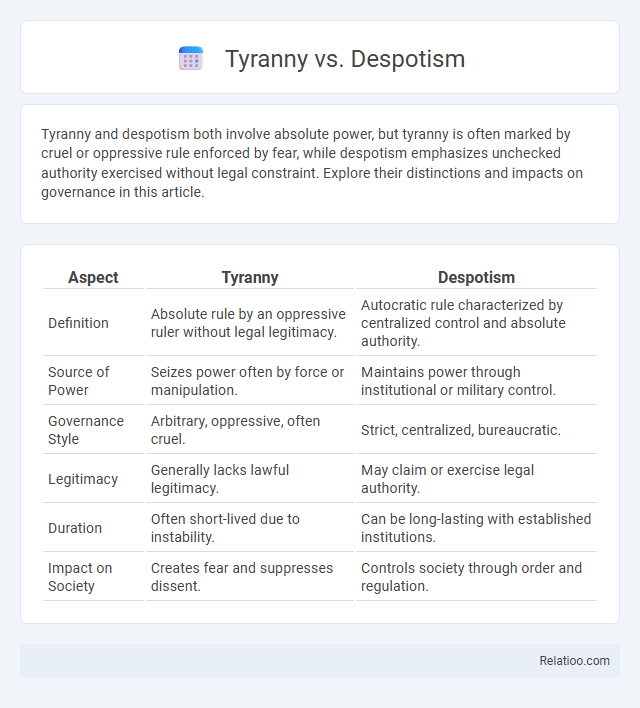Tyranny and despotism both involve absolute power, but tyranny is often marked by cruel or oppressive rule enforced by fear, while despotism emphasizes unchecked authority exercised without legal constraint. Explore their distinctions and impacts on governance in this article.
Table of Comparison
| Aspect | Tyranny | Despotism |
|---|---|---|
| Definition | Absolute rule by an oppressive ruler without legal legitimacy. | Autocratic rule characterized by centralized control and absolute authority. |
| Source of Power | Seizes power often by force or manipulation. | Maintains power through institutional or military control. |
| Governance Style | Arbitrary, oppressive, often cruel. | Strict, centralized, bureaucratic. |
| Legitimacy | Generally lacks lawful legitimacy. | May claim or exercise legal authority. |
| Duration | Often short-lived due to instability. | Can be long-lasting with established institutions. |
| Impact on Society | Creates fear and suppresses dissent. | Controls society through order and regulation. |
Understanding Tyranny: Definition and Origins
Tyranny, originating from ancient Greek, refers to a form of oppressive rule where a single ruler holds absolute power without legal constraint, often obtained through force or manipulation. Unlike despotism, which emphasizes centralized control through fear and authoritarianism, tyranny is characterized by the illegitimate and unjust exercise of power that harms the governed. Understanding these distinctions helps you recognize the historical and political nuances behind the concepts, clarifying how tyranny's roots in power abuse influence modern governance.
Defining Despotism: Historical Contexts
Despotism is characterized by absolute power held by a single ruler, often justified by divine right or hereditary succession, prevalent in historical empires such as Ancient Egypt and the Byzantine Empire. Unlike tyranny, which usually stems from illegitimate seizure or oppressive rule by an individual, despotism often involves structured governance with centralized authority over political, judicial, and military functions. Understanding despotism requires recognizing how Your perception of authority may contrast with these historical frameworks of unchallenged sovereign rule.
Key Differences Between Tyranny and Despotism
Tyranny and despotism both involve oppressive governance but differ significantly in their mechanisms and scope of control. Tyranny refers to absolute power wielded by a ruler who often seizes authority through illegitimate means, characterized by arbitrary and cruel rule, while despotism emphasizes centralized authority with strict control, often justifying actions as necessary for order and stability. Understanding these differences helps you discern the nature of authoritarian regimes and their impact on societal freedom and governance.
The Psychological Roots of Tyrannical Rule
The psychological roots of tyrannical rule often stem from deep-seated fears of loss of control and power, driving rulers to exert absolute authority over their subjects. Tyranny thrives on the ruler's insecurities and desire to suppress dissent, whereas despotism reflects a more institutionalized form of oppressive governance, relying on fear and coercion to maintain dominance. Understanding these motivations can help you recognize the patterns of psychological manipulation used by tyrants to sustain their regime.
Despotic Leadership: Traits and Consequences
Despotic leadership is characterized by absolute power concentrated in a single ruler who enforces decisions through fear, oppression, and unchecked authority, often disregarding laws and human rights. This leadership style results in widespread social unrest, economic instability, and the suppression of political freedoms, leading to long-term detrimental consequences for society. Despotic regimes typically maintain control through intimidation, censorship, and violence, fostering an environment of mistrust and limiting civic participation.
Power Structures: Tyrants vs. Despots
Tyranny and despotism both involve centralized power held by an individual, yet tyrants often rise through unconstitutional means and rely on fear and oppression, while despots maintain control through absolute, institutionalized authority. The power structure under a tyrant is usually personalistic, focusing on the ruler's arbitrary will, whereas despotism is characterized by formal governance mechanisms that enforce the despot's dominance. Understanding the distinctions in how power is structured and exercised reveals the different methods these rulers use to consolidate and maintain control over their states.
Case Studies: Tyranny in Modern History
Tyranny in modern history is exemplified by regimes such as Nazi Germany under Adolf Hitler and the Soviet Union under Joseph Stalin, where absolute power centralized in one leader led to widespread human rights abuses and suppression of dissent. Despotism differs by emphasizing the absolute authority of a ruler, often exercised through fear and oppression without legal restraint, as seen in Saddam Hussein's Iraq. These case studies highlight how tyranny combines autocratic rule with systematic violence to maintain control, whereas despotism generally concentrates on authoritarian rule enforced by arbitrary power.
Famous Despots: Patterns Across Cultures
Famous despots such as Joseph Stalin, Saddam Hussein, and Adolf Hitler exhibit patterns of absolute power consolidation, suppression of dissent, and centralized control across diverse cultures. Tyranny and despotism both involve authoritarian rule, but despotism typically indicates more overt, centralized autocracy with arbitrary governance. Historical analysis reveals how despotism transcends cultural boundaries through shared tactics like propaganda, political purges, and militarized enforcement.
The Impact of Tyranny and Despotism on Society
Tyranny and despotism both undermine societal stability by concentrating power in the hands of a single ruler, leading to widespread oppression and the erosion of civil liberties. These authoritarian systems often suppress dissent, stifle economic growth, and foster an environment of fear and inequality that hinders social progress. Understanding the impact of these regimes can help you recognize the importance of protecting democratic institutions and promoting human rights.
Combating Tyranny and Despotism: Lessons Learned
Combating tyranny and despotism requires understanding their distinct characteristics: tyranny often involves cruel and oppressive rule by an individual, while despotism entails absolute power exercised without legal constraint. Historical resistance movements highlight the importance of collective action, institutional checks, and legal frameworks in dismantling authoritarian control. Your role in promoting civic engagement and supporting transparent governance is crucial to preventing the resurgence of such oppressive regimes.

Infographic: Tyranny vs Despotism
 relatioo.com
relatioo.com